Chapter 6
Shooting Fun Stuff with Your GoPro
IN THIS CHAPTER
![]() Wearing your GoPro well
Wearing your GoPro well
![]() Capturing thrills at the amusement park
Capturing thrills at the amusement park
![]() Shooting action of your favorite sports
Shooting action of your favorite sports
![]() Making your own action
Making your own action
![]() Flying a drone
Flying a drone
Once upon a time, those edge-of-your seat extreme action scenes were best left to the professionals. Compelling, yet risky situations like base jumping, extreme biking, or shooting from a high-speed roller coaster required a certain skillset for capture — with a good part of that skillset being the ability to keep yourself out of a body cast. Even slightly less intense action like mountain biking or skateboarding posed a potential threat to your physical safety, not to mention the equipment. Adventurous shooters often left behind a trail of smashed cameras, shattered lenses, and broken dreams.
GoPro changed the game, allowing you to capture thrilling situations while keeping you and the camera safer. With the right flair, you can introduce excitement to your movies and photos, without necessarily putting yourself in harm’s way. By no means does that give you license for recklessness, especially where your life is concerned. It’s just that some situations look daring, yet are no longer as dangerous to shoot because you’re not attached to the camera as much. Simply put, mounting the camera and controlling it from a distance can keep you and the camera safe. Other situations are bit more docile, so you can hold or wear the camera, while still providing a thrill for the audience.
Using Wearable Mounts
Wearing a GoPro is the latest rage in fashion, said no one, ever. But what these wearable mounting options lack in fashion sense, they make up for in practicality. While you can handhold your GoPro, it’s simply better to mount it when shooting movies or taking pictures. Handholding your GoPro isn’t much different than walking your cat on a leash. Yeah, it’s possible, but there’s something unnatural about it. Instead, cats do better when untethered from your hand, and so does a GoPro. This mighty little camera was meant for mounting, and one of the best ways to do it is by wearing it. You can read about the individual ways in Chapter 2, and say, “Look Ma, no hands.”
Is that a camera on your head?
It’s highly unlikely that wearing the Head Strap lands you on the cover of GQ or Vogue, yet it does provide the ultimate perspective for a POV shot. Thanks to the camera being so close to your eye line every time you turn, pivot, or tilt, the viewer can feel what you feel and see what you see. So, while resembling something between a spelunker and a walking bipod, you can capture each situation with a compelling perspective, as shown in Figure 6-1.
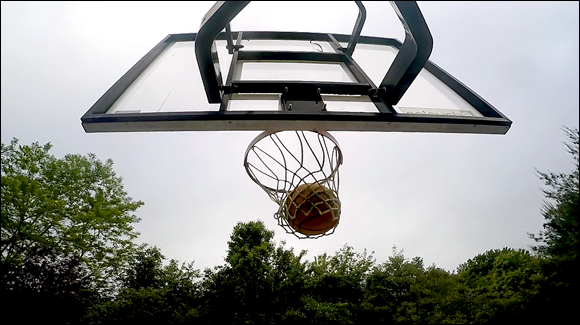
FIGURE 6-1: This nothing-but-net shot was made possible by wearing a GoPro on a Head Strap under the basket and just looking up at the action.
Here are few tips for doing it as gracefully as possible:
- Walk at a steady pace: Even, level strides lead to smooth, professional looking capture, while the not-so-even ones scream to the viewer that you have a camera stuck to your head.
- Fit it comfortably: The Head Strap is adjustable, so the better it fits, the better your chances for stable video, not to mention also keeping it from falling off your head. (Taking the time necessary to fit the attachment comfortably is of particular importance if it is to be worn over extended periods of time.)
- Limit jarring moves: While we’re used to moving our heads rapidly at times, it doesn’t always translate to video, unless of course the goal was to make people queasy. Instead, pretend you’re in slow motion and make slow, deliberate motions as you change camera perspective.
Wearing the camera in a crowd
When it comes to using a camera in close quarters, GoPro seems perfect for shooting in a New York City apartment. Because it offers the perfect combination of diminutive size, ultra-wide-angle lens, and fashionable wearability — all right, maybe fashionable is a stretch — GoPro is the perfect camera for capturing subjective perspective on the move as you navigate through a sea of humans. Standing in lines, meandering through a crowd, or Walking on a busy city street can all produce impressive imagery when wearing your GoPro camera on the Head Strap, Chesty, or using the Strap.
Here’s some advice when wearing the camera around a lot of people:
- Use the app to monitor: While personal perspective is charming, accurate composition is sublime. That comes from using the screen as an aid to effectively navigate the shoot, control settings, and adjust the angle of view.
- Watch your step: Since it’s unlikely you’d want to trip over a curb, bump into someone, or have a pedestrian collision, it’s important to be careful when you’re capturing a scene in the middle of a crowd. So, walk carefully, and keep an eye on where you’re going when watching the monitor.
- Keep a safe distance: Not just because you want to avoid contact with other humans, but also because being too close to the subject can affect focus, and not in a good way.
- Chest or head: Sometimes you get the orchestra, and other times, you get the balcony. You know, top and bottom. Wearing a GoPro on your head or chest is the same way. Each has its own charm with a specific purpose. Wearing the camera on your head lends itself nicely to those point-of-view shots with twists, turns, and peeking inside places. Wearing a GoPro on your chest is more stable and better for linear walks through a crowd. One problem, though, is that it points slightly downward.
Capturing life behind the scenes
Sometimes working the crowd relies less on walking the line and more about making the viewer feel privy to something that seemed off-limits. Take them on a walk-thru of a house you’re looking to sell, backstage at a rock concert, or on the field for the festivities of a sporting event (see Figure 6-2). All these situations come to life when you depict them from your point-of-view. It makes the audience feel like they’re walking through the scene.
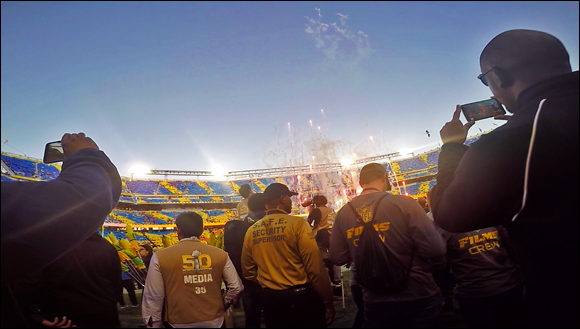
FIGURE 6-2: Wearing the camera on a Chesty provides this intimate view of the field during a firework display.
Consider the following:
- Be deliberate: Move slowly through the scene so that the viewer can absorb the action. If you’re shooting a real estate video, walk slowly so that the viewer can see the key features of the dwelling.
- Get up close and personal: Walk closer to the more interesting parts of the scene, and stay on them to help the viewer know those parts are important. For example, if you’re backstage at a concert, meandering through the circus atmosphere before the show can make an interesting scene. You can watch the guitarist tune up, watch the band play before an empty venue at a sound check, or record the drummer gorging at craft services.
Not everyone has access to all situations, yet there’s always something that you can shoot. Here are a few places you can try:
- Construction sites
- Real estate viewings
- Sporting events
- Amusement parks
- Museums and galleries
- Family picnics
Strapping the camera on a limb
The Strap is the newest wearable mounting accessor that fits over any of your appendages. Wear it on an arm or leg so that you can capture uniquely immersive POV footage, capturing the scene, literally hands-free. This comes in handy, no pun intended, for situations that demand the attention of your hands, like riding a horse, swimming underwater, snowboarding, and other activities. The mount is fully adjustable with a 360 degrees rotation and tilt for maximum control.
Shooting on Amusement Park Rides
Taking your GoPro to the theme park lets you relive the thrill of screaming your head off without any of the motion sickness that sometimes goes with it. It sounds like a win-win when you’re out there recording the energy of a roller coaster, the exhilaration of a water ride, the simple aesthetic of a carousel ride, or the freedom of the chaired swing ride, as shown in Figure 6-3. Each situation provides different levels of adventure, albeit one being more dulcet than the others. It’s the last one if you weren’t sure, and one of the most interesting.

FIGURE 6-3: By securing the camera with the Head Strap and setting the camera on Burst, it was possible to enjoy the ride and capture this still image.
Consider the following when recreating the magic of your day at the amusement park:
- Putting safety first: While each attraction offers its type of thrill, you should always err on the side of caution by abiding by the rules of the ride. Keep your hands and feet inside, and don’t wear the camera in a way that affects any restraints.
- Loving the POV shot: Effectively capturing your point of view lets you recreate the excitement of the ride as your eyes saw it. Both the Head Strap and Chesty let you subjectively capture this view. Both mounts are effective. Wearing the camera on your head better matches your eye line, creating a more natural perspective. Wearing it on your chest produces a lower angle, as it naturally sits downward.
- Capture your expression: Turn the camera around and record the look on your face as you negotiate the ride, or more appropriately, capturing the most fun kind of selfie. All right, it doesn’t have to be you. Regardless of whose expression you capture, you must be careful where you mount the camera in the name of safety. Common sense dictates not mounting the camera on the ride itself.
- Shoot photos on Burst: When shooting movies, you can start recording before the ride takes off, but still photography is more challenging. So instead of trying to shoot single frames, it’s best to set the camera on Burst. It can capture up to 30 pictures per second.
Exaggerate the ride experience
Like the fresh taste of a piece of bubble gum, the average roller coaster ride lasts around two minutes. And while you always wish both lasted longer, it’s doubtful your audience feels the same way about your footage. Perhaps the axiom, less is more, acts more like the rule when it comes to how much you show the viewer. Shoot the entire experience, but just show a sliver of the action in the movie.
Here are some suggestions:
- Time-Lapse: Even the most moderate interval setting for a time-lapse can make the action appear 15 times faster than normal. That 40-mph ride can appear as if it’s moving at 600 miles per hour, rendering it like hyper-drive.
- Slow Motion: What is more ironic than reducing the super-fast activity of a ride moving 40 miles per hour to one that creeps at a snail’s pace. When using this mode, you want to shoot at the highest possible frame rate. And if you shoot at 720p, you can use a frame rate of 240 fps.
- Play in reverse: While you can’t do it while shooting, it’s certainly possible during playback. It makes for a fun viewing experience when you capture someone diving into the pool head first to coming out of the water feet first to the diving board. Or a busy street scene filled with pedestrians walking backwards.
Mastering each attraction with the right panache
Common sense dictates that your approach to capturing the thrill of a heart-stopping ride is not the same as shooting something more graceful. Rollercoasters and carousels are as distinctly different as oil and vinegar, and so are the techniques for effectively capturing them. Both collectively make your movie interesting, yet are completely different in every way, so each requires a different approach for capture.
Having fun on the roller coaster
When it comes to shooting a roller coaster, GoPro lets you relive the oohs and ahs of the deep drops, sharp turns, and your own falsetto screams. Capturing those brief moments are as simple as wearing the camera on the ride and pressing record to recreate a subjective perspective of the thrill. Sitting in the front of the ride provides an unobstructed view, as seen in Figure 6-4, but that’s not to say you can’t get great footage from the middle or even the rear.

FIGURE 6-4: The Head Strap provides a clear perspective at the top of this roller coaster.
Let’s look at the different kinds of shots.
- POV: Show the ride as you see it by wearing the camera on your chest or mount it close to your own perspective using a Head Strap, Chesty, or the Strap. (Use it on your arm, wrist, or leg.) You can show a subjective view, people raising arms in front of you, or looking upwards.
- Selfie: Turn the camera around and allow the viewer to read the action from your expression, including the shrieks and screams.
- Working the angles: Just because you’re not on the ride doesn’t mean you should put the camera away. Capturing the ride as a bystander lets you create an objective wide shot that works out for editing. The wide, medium, close-up approach for shot sequence works well, especially when the goal is editing a cohesive package.
When on the rides, there are some other issues to consider:
- Being careful: Unfortunately, it’s not always safe to bring your camera on a roller coaster or even always allowed by officials, so you must proceed with caution. If you can bring the camera on the ride, be sure it’s firmly mounted and does not fly away. You can lose it, break it, or worse, hurt someone.
- Abrupt movement: The rides move very fast and sometimes come to a screeching halt. Literally, you’ve heard that sound before. So, make sure the camera is secure or it can be knocked out of your hand. If that happens, losing the camera is not the worst thing that can happen; you can hurt someone, too.
- Privacy issues: I’m going to go out on a limb here, but most people don’t like being part of a movie they were not asked to be in. That goes double when they’re at their most visually vulnerable, replete with bad hair and angry scowl. It’s better to record people that you know — friends and family — to avoid any issues. Of course, you can always ask for contact information and get permission too.
- Shoot at a higher frame rate: Shooting in 1080p with a frame rate of at least 60 fps will help assure the action is crisp.
Shooting water rides
Whether sliding down on a raft, a log-like Flintstones car, or with your own body, water rides are like rollercoasters under really wet conditions. Capture your point of view as you’re screaming joyfully — or panicky — all the way down. It’s pretty much the same idea as shooting on a roller coaster, with one caveat: the water part. Electronics are allergic to H2O and that makes it challenging at times to see what you’re seeing since you can’t use your app or have access to the camera, even if there’s a screen. But these problems are easily fixed when you take heed of the following.
- Secure the camera: Holding the camera under normal circumstances is a tricky endeavor. Moving makes it harder, and doing it under wet circumstances makes it even trickier. Try to wear the camera, and if you can’t, hold it tight.
- Keep the lens clean: Water droplets on the lens are an occupational hazard, and can rob the image of sharpness or image quality. So, give it a wipe every so often.
- Have faith: You can’t use the app (unless you want to short-circuit your smartphone), so just point the camera in the right direction and hope for the best.
Capturing the carousel experience
The carousel does not provide quite the same thrill as a roller coaster — unless you find individually painted ponies thrilling — but it’s still one of the most photographed places in an amusement park (see Figure 6-5). Due partially to the timeless elegance of each carousel, not to mention being the perfect vehicle to capture small children and everyone else that doesn’t like big rides.

FIGURE 6-5: Thanks to its ultra-wide view, you can capture some great shots on a carousel with your GoPro.
Here are a few aspects to consider:
- Wear the camera: Wearing your GoPro as the ride goes round and round and up and down makes for an interesting movie. And you’re doing nothing more than wearing the camera as an accessory.
- Move with the ride: The nature of a carousel means that you’re always on the horse in back and the horse in front. You will never catch up to the horse in front or lose your lead to the horse behind you. But the action outside of the ride, as well as the up and down nature of the ponies does change allowing you to capture action without leaving your seat, er saddle. If you’re standing and walking, then all bets are off.
- Focus on the horse: That’s meant both figuratively and literally. It’s not always a horse; sometimes it’s a tiger or another exotic animal. While you can shoot other aspects, the painted horse, for this discussion, is the main attraction. Their unique colors and adornments make each one visually unique, so when you add a little motion … voilà!
Round and round on the Ferris wheel
Colorful, circular, and colossal (at times), the Ferris wheel is one of the most iconic symbols of an amusement park. Maybe it’s not as thrilling as other action rides — unless, of course, if you’re afraid of heights — but it does make for visually interesting movies and pictures (see Figure 6-6).
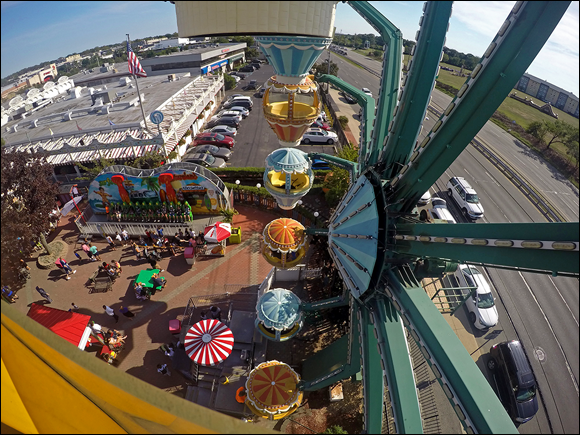
FIGURE 6-6: View from the Ferris wheel.
Consider the following:
- Long exposure still image: All it takes is a two-second exposure while the ride is in motion to produce beautiful streaks of color. Try to make sure you fill the frame with the entire ride, but that should be no problem with your GoPro.
- Time-Lapse: Position the camera nearby and set an interval of a half-second or more to record the ride’s rotation as colorful streaks. Don’t be shy capturing the ride from afar.
- Movie: Capture the ride from a distance or shoot from your perspective on the ride itself.
Recording Sporting Events
Shooting sports takes on a different life when capturing action scenes with your GoPro. Unlike shooting from a distance with a DSLR and a long lens, the GoPro requires far more intimacy with the subject; in other words, you need to be very close. That means sitting in Section 5 Row 20 of an arena or stadium will more than likely yield better shots of people’s heads than any sort of decipherable action. That means with few exceptions, it’s not very good for capturing organized sporting events. Conversely, it can work beautifully with the not so organized variety. Activities like a pick-up basketball game, volleyball at the beach, or whiffle ball at a family picnic can produce content for your own version of Sports Center, or something viral on YouTube.
Bringing your camera to a baseball or football game can have a lot of restrictions, yet there are no rules prohibiting you from wearing a camera at a pick-up game with your friends to get some cool footage. You don’t even have to concentrate on the game, as you can just shoot random action that makes for impressive movie clips, or just horse around (see Figure 6-7).
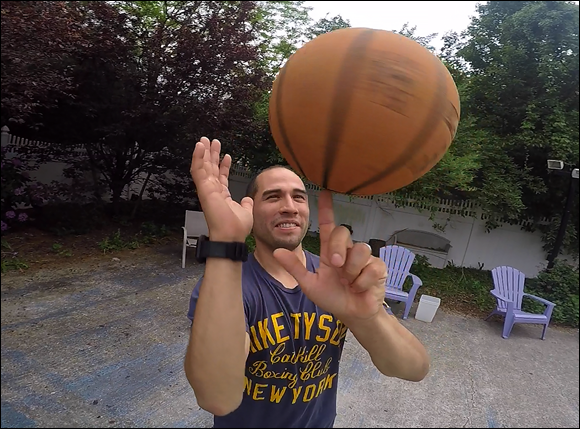
FIGURE 6-7: Sometimes it’s as much fun to capture things like taking the ball for a spin.
Here are some examples of capturing sporting events with your GoPro:
- Whiffle ball: That entry-level game with the plastic yellow bat and tricky vented ball can make for pretty cool movies and pictures, especially since the ball curves like no other and a hard-hit ball doesn’t travel very far. Wear the camera with a Chesty or on a Head Strap while pitching, fielding, or hitting. And speaking of the latter, you can mount the camera on the bat using a handlebar mount to capture the bat and ball making contact from inches away.
- Basketball: It’s a pretty rough sport to wear the camera, but that doesn’t mean cool action shots are off the table. Everybody loves ball tricks (see Figure 6-7). Maybe you want to mount the camera on the backboard, or stand underneath it to capture that “nothing but net” feeling, as shown previously in Figure 6-1.
- Football: It’s strongly advised not to wear a camera during the game, unless you want to be flagged for unnecessary roughness to the camera. But that doesn’t stop you from capturing action from the sidelines. Whether it’s a friendly game of two-hand touch or a hard-hitting game of smashmouth football, mount the camera on a goalpost or position it inches from the field to get up close and personal. For practice situations, you can use the helmet mount or the Strap on your arm or wrist to follow the action or put it on your leg to capture a kick.
- Bowling: Despite the stellar physique of bowlers, league bowling can be an exhilarating sport. All kidding aside, it’s still a fun activity to capture in a variety of ways. You can wear the Chesty and capture the release of the ball on the lane or the Strap on your arm to show that perspective.
- Golf: Watching golf on television rarely lives up to the excitement of actually playing. Regardless of the emotional toll it takes on you, or more accurately the clubs, you can capture some pretty cool stuff with your GoPro in a variety of ways, including wearing the camera in some way, mounting it directly on the club, or positioning it nearby to capture teeing off or making a putt (see Figure 6-8).
- Volleyball: Create exciting imagery playing volleyball the next time you’re at the beach or a family picnic. Mount the camera to the post, position it high above the game, or wear it (at your own risk) to capture some fun action, especially if you’re playing on the beach.
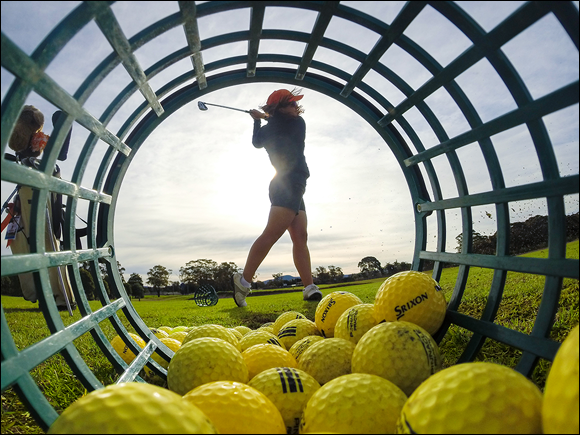
Photo courtesy of GoPro, Inc.
FIGURE 6-8: Shooting through the basket makes an otherwise boring composition look more interesting.
GoPro and the Water
Since a powerful waterproof camera sounds like something out of a fairytale, let’s begin by saying once upon a time most cameras were deathly allergic to water. And while you could also use an expensive waterproof housing on your video camera or DSLR, all it took was a little moisture for your equipment to be ruined. But GoPro with its waterproof housing doesn’t shrink or melt. In fact, GoPro and water go together better than movie theater popcorn and imitation butter.
Using GoPro at the pool
The endless possibilities for capturing great movies and pictures around the backyard watering hole could make Forest Gump’s mouth spit out a litany of similes. Whether it’s as serious as capturing junior’s practice for an upcoming swim meet, the spontaneity of a bonkers pool party, or the serenity of an underwater portrait, GoPro should be in demand around the pool.
Here’s what you can do:
- Capture action in the pool: Not that long ago bringing a camera to the pool could be misconstrued as a sign that there was a new camera in your future. But with GoPro you can easily record the frolicking and splashing, in and around the pool area.
- Mount it to yourself: Wear the camera on your head, your chest, or hold it while walking around the pool, swim under the water, or hold the camera for practical control. If you choose the latter, make sure that the camera can float, either by mounting to The Handler or having a Floaty on it.
- Shoot the subject hitting the surface: Capture someone breaking the plane of the water as they jump or dive in. Position yourself near the point of entry, even under the water.
- Capture underwater activity: Whether you’re capturing a surrealistic portrait of your significant other, your daughter holding her nose under the water for the first time, children swimming underwater (see Figure 6-9), or a unique portrait, you can create beautiful images beneath the surface.
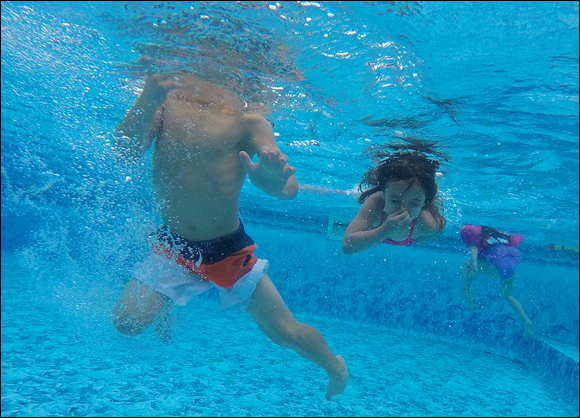
FIGURE 6-9: Kids having fun beneath the surface of the water are no problem for GoPro.
Shooting water sports
Marco Polo takes on new meaning when GoPro is in the pool showing the chase. The counting, swimming, and the calling out of the name of the game all make for a fun movie at the end of the day. The same holds true for other exhilarating water sports, such as volleyball, basketball, or underwater races. Basically, anything you can play in the water that’s competitive is a good match for GoPro.
While many of these activities are distinctly different, here’s what you should consider:
- Visualize what you want: There’s an old saying that goes “You can’t get what you want, until you know what you want.” That applies to many situations you will capture with your GoPro, especially here. Think about how you want the audience to see your movie, and capture it with that intent.
- Make sure the camera can float: Seems like a no-brainer, but you would be surprised. All it takes is a Floaty or the Floating Hand Grip to keep your runaway camera on the surface.
- Don’t be afraid to get under the water: Some of the coolest scenes are captured below the surface. Just make sure your housing is watertight.
Take GoPro to the beach
GoPro cozies up as nicely at the beach as a blanket and an umbrella. It’s small, lightweight, and fits anywhere, so it’s not a burden to lug around. And the housing protects the camera by keeping out water, sand, and other debris, making it easily accessible to capture movies and stills in places where you had to be more careful before.
Here are some things to keep in mind when you bring your GoPro camera to the beach:
- Fun on the sand: Throwing a Frisbee around, running in surf, making sandcastles, playing volleyball, and anything else you do at the beach are perfect situations to capture, without fear of sand or water damage.
- Wave jumping: Wear the camera as you negotiate each wave with awkward precision. Just be careful you don’t drop the camera or it doesn’t break free; otherwise it will end up in Davey Jones’s locker.
- Underwater scenes: Going underwater to make movies or photographs of the seascape is easy with your GoPro. Just make sure you have something that allows the camera to float, or it will be gone forever.
- Surfing: There’s a special mount designed specifically for your board, shown in Figure 6-10, so that you can hang ten while yelling “cowabunga,” or screaming at a wave, or sometimes for your life. See Chapter 2 for more information on this special mount.
- Body surfing: Wear it while riding the board or mount the camera to the board so you can capture the experience.
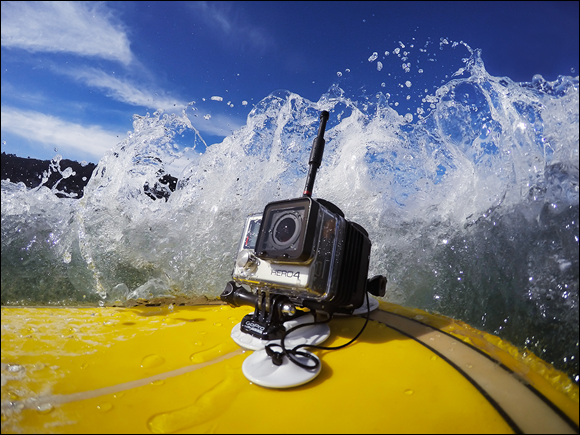
Photo courtesy of GoPro, Inc.
FIGURE 6-10: You can easily mount your GoPro with the surfboard mount.
Using GoPro on a personal watercraft
The personal watercraft resembles the offspring of a motorcycle and a powerboat. Known more familiarly by a bunch of brand names like Sea-Doo, Wave Runner, or Jet Ski, these water scooters are thrilling to ride and just as exciting to capture with your GoPro.
Here’s what you can do:
- Mount on the vessel: Depending on the model, you can use the appropriate mount to provide a subjective view of breaking waves. Just use common sense and place it in where it doesn’t interfere with your safety or anyone else’s.
- Wear it: Probably the best way to capture those special moments on the water is to wear the camera. Put on the Chesty for a subjective view for commandeering the vessel. It does have a slightly downward view, acceptable under certain conditions. You can also use the Head Strap, though there’s a chance it can fly off your head, leaving you strapped for a camera. And if it happens there, it’s even more of a risk while handholding — unless your goal is losing the camera rather than capturing thrilling footage.
Movies on a boat, movies in the moat
Whether you’re navigating a kayak through marshlands, capturing the thrill of an outrigger canoe hitting that massive wave, or zipping around the bay in a motorboat, your GoPro is up for the challenge, transforming nautical time into compelling movies and photographs (see Figure 6-11).
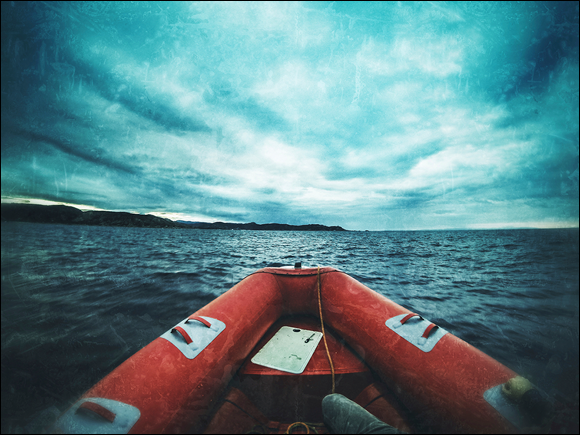
©istockphoto.com/piola666 Image #37074252
FIGURE 6-11: Point-of-view shot.
Here are some ideas for positioning the camera:
- Mount it: Depending on the boat, there are numerous places you can mount the camera. These include any smooth (and clean) surface for the suction cup, various bar mounts, or the more permanent adhesive mounts.
- Hold it: It’s a bit risky, especially when hanging the camera over the edge of the boat, but you can control the composition more precisely than stationary mounts. Make sure you’re using some flotation accessories to be on the safe side. And the safe side for a camera that falls in the water is the side above the surface. Tethering the camera to the vessel, or even yourself, can also help.
- Wear it: Channel your inner Leonardo DiCaprio as you stand on the bow screaming “Kink of the oiled,” or something like it with the camera on your body, preferably with the Chesty.
Making fishing interesting
Regardless of your reason – you know, food or sport — angling over a watering hole takes on new meaning when attaching your GoPro to your fishing pole. Using the Sportsman mount lets you capture those great moments on the water from a poles-eye view (see Figure 6-12). Now you can finally record that moment when you reel in the big one. The only problem is that you can’t exaggerate the size of the one that got away, unless you got it on video.
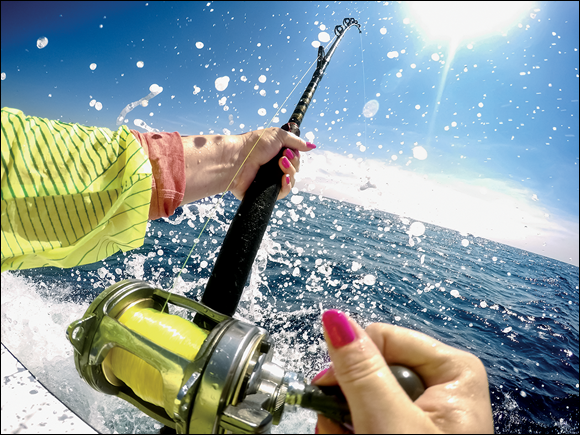
Photo courtesy of GoPro, Inc.
FIGURE 6-12: GoPro lets you get up close and personal on the high seas.
Consider the following when capturing your day on the water.
- Mount the camera: Put GoPro on your fishing pole using the Sportsman mount, so you can capture the pole at work.
- Wear the camera on your head: Record the experience like your eyes would see. You know, stuff like casting, reeling, or reeling in the big one.
- Use an extension pole: It’s the fish’s version of the selfie stick. Hold the camera over the action, almost like you would a net for a unique view.
All Kinds of Bicycling
When it comes to one of the most accessible places for capturing action, it’s hard to imagine a better combination than a GoPro and a bicycle, other than sunscreen and a scorching hot day at the beach. Whether you’re navigating a mountain trail, going on a scenic tour, or riding one of those city rentals, bicycling is one of the more popular activities you can capture with your GoPro, and that’s meant in both the literal and figurative sense. And unlike vanilla ice cream, none of this has to be too bland. There’s a bunch of situations to capture with various mounts and techniques that can pepper the imagery. Don’t worry if the bike isn’t powered by you because you can substitute many of these shots on a motorcycle or ATV.
Let’s consider some of the cool ways to use your GoPro while peddling around:
- Mount it on handlebars: Several choices are possible, including the standard handlebar mount, or the new Pro Handlebar mount. That one allows you to rotate the camera 360 degrees for unlimited capture options; facing forward, it provides a subjective perspective. Or you could turn it around, and show the viewer your expression and all that you pass. (See Figure 6-13)
- Point it downward: Regardless if you wear the camera on your chest or have it mounted on a frame, you can show the ride from the perspective of the front wheel turning, pedals cranking, or terrain the bike has passed.
- Use the helmet mount: Allows the viewer to experience the ride at an angle of view much closer to your perspective, and it’s also safer than using the Head Strap for both you and the camera. (See Figure 6-13.)
- Hang it: The new Pro Seat Rail mount clamps to the back of your seat, allowing you to capture a low profile, rear-facing camera position. This perspective captures everything and everyone travelling behind the bike.
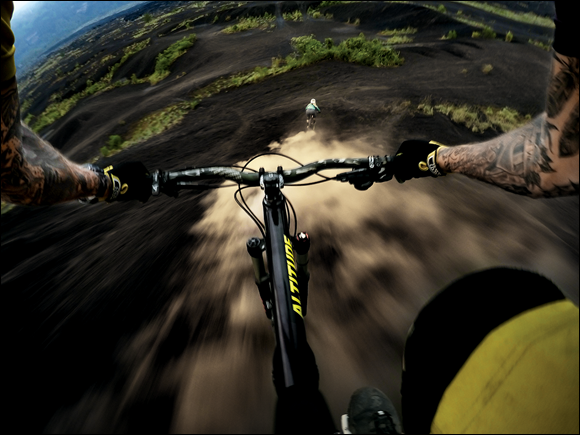
Photo courtesy of GoPro, Inc.
FIGURE 6-13: Share the rider’s perspective with the helmet mount.
Taking Flight with Your Karma Drone
Aboard the Karma drone, your GoPro can soar over whatever corner of the world you call your own, allowing you to capture a rarely seen perspective for your movies and still photos. It’s like giving Peter Pan a camera and asking him to capture the rooftops of your town, only you’re doing it with a remote control and don’t have to deal with his boyish tantrums. The Karma — or any other drone that holds a GoPro — lets you see places you may not venture toward, and from a perspective you’re not accustomed, without ever putting you in harm’s way. But it’s important to understand how to operate it and the local ordinances to keep Karma, yourself, and others safe.
Practice makes perfect
While your Karma drone can capture impressive video from extreme heights without putting you at risk, the same cannot be said for your Karma. Simply put, the physical reality of what goes up must come down applies and works here, unless, of course, it comes down too quickly or perhaps veers off course into a wall. It’s such a downer when you have to take your drone home in pieces. That’s why practice is so important.
Consider the following:
- Read the instructions: When you take your drone out of the box, resist the urge to start flying until you understand how to use it. Instead, charge the vessel and remote and read the instructions.
- Find a flat, spacious place: The best way to get comfortable with taking off and landing is to practice. Choose a park or open field for those early missions.
- Stay away from trees: Trees are the drone’s natural enemy. Flying too close to a tree never puts you on the winning end, as your drone can get stuck on a branch, or lose a rotor. That’s why you should look for an open area when you’re first getting started.
- Fly on a calm day: All it takes is a wind gust to take your drone off course and slam it into something hard (resulting in damage) or send it far, far away (and lose it).
- Start off slow: Practice take-offs and landings, gradually going higher and farther. Afterwards you can practice how to move and control the camera.
- Stay on top of industry education: Visit the Academy of Model Aeronautics:
http://www.modelaircraft.org/
Fun places for your Karma missions
Once you’re feeling confident to fly, you can have fun with your Karma drone. Here are some ideas for missions you can try:
- Take it to the beach: The shoreline usually provides a great place for flying your Karma drone for several reasons. The wide-open space means you can fly in an unobstructed airspace, free of trees and buildings. But more important, the shore is a beautiful place to shoot the sea, surf, and sunbathers. Just be aware, some people may find a GoPro flying overhead to be intrusive.
- Shoot a real estate scene: Whether you’re a real estate agent capturing that unique view for your next sale, a homeowner looking to add interesting visuals to your home listing, or simply want to create a visual record of a piece of property, flying the Karma drone overhead will help you show an impressive view.
- Capture action sports: Have fun at your next company softball game, beach volleyball match, or surfing competition. These are just a few of the events you can capture from overhead. Just be careful to not fly too close to the action.
- Record something you can’t normally see: For all those times you were curious of what was on the other side of a wall, the scene beyond a ridge, or over a bridge, you can now satisfy your curiosity with your drone.
- Shoot a firework display: Flying your Karma above the bursts provides a perspective that was rarely possible a few years ago. Just be aware of any ordinances before you take off.
